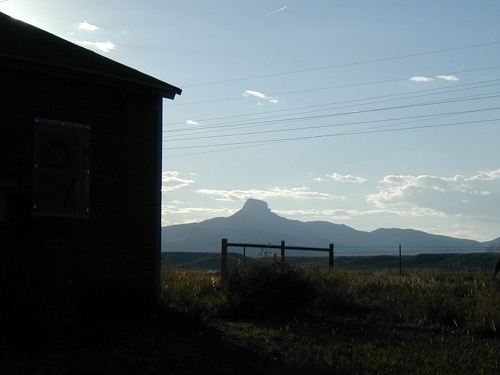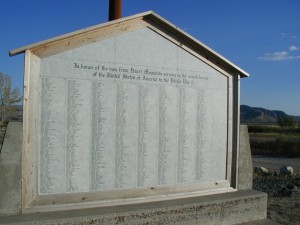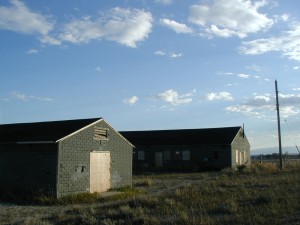
It’s a fact: The 10 concentration camps built during World War II to imprison 120,000 people of Japanese descent — more than half U.S.-born and therefore American citizens, and most of them mere children — were all thrown together in godforsaken corners of the country.
No offense to people who live near the sites of these former “relocation centers” (a silly government euphemism that was easier to swallow than the words “concentration camp” that President Roosevelt himself used), but Camp Amache in southeastern Colorado is a forlorn, dusty expanse of whole lot of nothing for miles and miles. It takes four hours of driving through mostly flat, dull prairie to get to the town of Granada from Denver.
It takes nine hours on on the road from Denver to get to Heart Mountain, although the drive is a little more scenic, to the base of a towering peak north of Cody, Wyoming in the northwest corner of Colorado’s neighbor to the north. For years, like at many of the concentration camps from the war years, there has been only a couple of memorials erected by former internees, and only a couple of buildings, including several of the dilapidated barracks buildings within view of the camp’s namesake mountain. Most of the buildings and equipment were sold off to ranchers after the war; like many of the camps, non-profit groups have been tracking down and reconstructing buildings if they’re available and still standing.
Heart Mountain is notable for a couple of reasons: It’s where Bill Hosokawa, the journalist from Seattle, was interned for 13 months before getting a job at a newsaper in Iowa during the war. After WWII, Hosokawa moved to Denver andsoent the rest of his life as a reporter, editor, diplomat and civil rights leader. And, Heart Mountain is the camp where a group of draft resisters became notorious and were eventually sentenced to Federal prison for simply refusing to accept being drafted out of camp when their families had lost everything and were unjustly imprisoned by the US government. This is one topic that still needs to be explained and taught about (I’ll be writing a review of “Conscience and the Constitution,” an excellent documentary about the draft resisters, soon.)
We’ve driven to Heart Mountain, and were chilled by the desolate majesty of the locale.
The mountain itself is a powerful image, one that adds an iconic feel to this camp that Amache in Colorado doesn’t have (it’s just flat and empty all around). We stopped at a florist and gift shop between Cody and Heart Mountain where a woman who was interned at the camp still worked, decades later. I wish I still had her name and number.
But over the years, the Heart Mountain Wyoming Foundation has been working diligently — and quietly — on building an 11,000 square feet facility at the former camp site that includes exhibition space and a theater. The Heart Mountain Interpretive Learning Center (ILC) opens this weekend with sold-out events that will be attended by some very high profile special guests.
Here’s a list of the speakers and invited VIPs for Friday’s All-Camp Get-Together and Pilgrimage Dinner at the Park County Fairgrounds, and saturday’s dedication ceremony at the ILC at the former camp grounds:

Guest Speaker Tom Brokaw, Pilgrimage Dinner
Kicking off the weekend, broadcast journalist and author Tom Brokaw will be special guest speaker at the Pilgrimage Dinner on Fri., Aug. 19. One of America’s most trusted and respected journalists, Mr. Brokaw anchored “NBC Nightly News” for 21 years and is now a special correspondent for NBC. A best-selling author, his book “The Greatest Generation” chronicles America’s World War II generation and includes the story of the incarceration of Japanese Americans.Keynote Speaker Sen. Daniel Inouye, ILC Dedication Ceremony
Delivering the keynote address at the ILC Dedication Ceremony on Sat., Aug. 20, will be Hawaii Sen. Daniel Inouye. As president pro tem of the Senate, he is the highest ranking Asian American elected official in U.S. history. A war hero and respected legislator, he advocated to establish the commission that issued the report “Personal Justice Denied,” which led to passage of the Civil Liberties Act of 1988, granting token redress payments to surviving Japanese Americans incarcerated during WWII.
Sec. Norman Mineta and Sen. Alan Simpson, Introduction Remarks
Introducing Sen. Inouye at the Dedication Ceremony will be two statesmen who met at Heart Mountain as Boy Scouts when one was incarcerated there with his family and the other belonged to a troop in his nearby hometown of Cody. Former U.S. Sen. Alan Simpson, who serves on the HMWF Advisory Council, and former Congressman and Secretary of Transportation Norman Mineta, became lifelong friends. And both were co-sponsors of the Civil Liberties Act of 1988.Panel of Experts, Grand Opening Banquet
At the Grand Opening Banquet the evening of Sat., Aug. 20, a panel of distinguished experts will discuss the Japanese American experience during WWII, commenting on legal, psychological and legislative perspectives and how lessons from the past inform today’s civil rights discussions:
Ms. Irene Hirano Inouye, former president and founding CEO of the Japanese American National Museum in Los Angeles, and current president of the US-Japan Council;
Judge Lance Ito, Los Angeles County Superior Court Judge and respected advocate for judicial reform, whose parents were incarcerated at Heart Mountain;
Sec. Norman Mineta, a member of the U.S. House of Representatives for more than 20 years, and the first Asian American named to a cabinet post, serving in two presidential administrations.
Dr. Melba Vasquez, president of the American Psychological Association and recognized expert in multicultural issues.
Unfortunately, we can’t make it to Heart Mountain for this grand opening ceremony, but we’re looking forward to returning to Cody and visiting Heart Mountain again. I hope the woman we met at the flower shop is still there, and will be attending the opening ceremony. What a sweet way to get some closure for the troubled times she lived through.
And, we’re looking forward to having such an educational facility built at Colorado’s Camp Amache some day.












I wish I could have been there for the dedication. My son Chris and I visited and car camped at Heart Mountain in 1995, watching the sun set and rise with Devils Tower looming in the distance. We visited the William F. Cody museum in Cody and saw the Heart Mountain exhibit there. On the way back I revisited the more appropriately renamed Little Big Horn National monument, which I had first visited in 1971 when it was called the Custer Battlefield monument. I recalled the look of disgust on Native American visitors as the park service ranger gave his spiel. We later camped on the homesite of a nephew of a former San Jose State judo team member, Ben Nighthorse Campbell in the Northern Cheyenne reservation. Norman Mineta was a youth counselor in my parent’s Wesley methodist church in San Jose, CA. As chairman of the SJ airport board, dad gave Norm his first info about airports and air travel…..
And now the SJ airport is named after Norm! Small world…. We’re thinking about driving to Heart Mt. again over Labor Day and I’ll write up a full report if we do. Thanks for your comment!
Pingback: Gil Asakawa: Half-Arab, Half-Jewish Woman & Two Indian Passengers Profiled on Frontier Flight on 9/11 | PUII - News Blog
Pingback: Gil Asakawa: Half-Arab, Half-Jewish Woman & Two Indian Passengers Profiled on Frontier Flight on 9/11 » Grubbyhub Blog - Get Your Latest Info Here!
Pingback: Gil Asakawa: Half-Arab, Half-Jewish Woman & Two Indian Passengers Profiled on Frontier Flight on 9/11 | Politimo
Just a small correction. Devil’s Tower is located in northeastern Wyoming nea
Thanks for pointing this out! I think Rod was referring to Heart Mountain itself, overlooking the camp, which I can see could be confused with Devil’s Tower… I think.
Hello, I visited Heart Mountain after reading Gretel Ehrlich’s book of the same name. I was living in Colorado and decided I must see this heart-breaking place. My memory may be faulty but, as I remember it, the only memorial at that time was a rather large rock with a plaque describing Heart Mountain relocation center. I believed it to be in Montana but others believe it was in Wyoming. The Cody Interpretive Center was built some years later. I do remember the barrenness of the land…just acres after acres of grass being blown in the wind. I swear I could hear the cries of the interned as I sat on the ground, praying for those who passed through this windy location. I thought that memorial and one building were in Heart Mountain, Montana. The plaque indicated that the memorial plaque was installed by a woman’s group from Cody, Wyoming. Am I completely off base? Thank you.
Hi, as far as I know, there isn’t a Heart Mountain in Montana. The incarceration camp for Japanese Americans, which is now a national historic site, is in Wyoming. I’ve been there, but before the museum /interpretative center was built. There was a replica of a barrack building and a memorial at the time. And the actual mountain of the name, of course…. I’ll have to find Gretel Ehrlich’s book. Thanks for the comment!